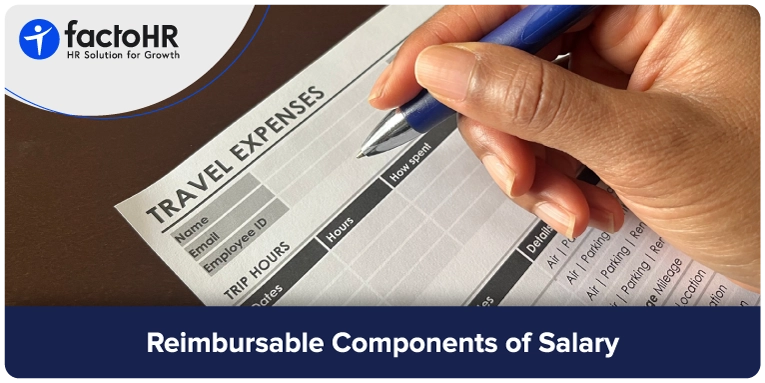Understanding Reimbursable Components of Salary in India?

Table of Contents
Employers often find managing payroll challenging. Payslips are often complicated with many numbers and abbreviations, making it hard to fully understand and administer employee compensation. One important aspect that is often overlooked is the Reimbursable components of salary, which are included in an employee’s take-home pay along with their base salary.
Payroll can be challenging for employers to understand, especially with all the different parts involved. Reimbursement might seem like a small detail, but they’re essential. Getting a clear grasp on these can help you manage payroll better and make sure everyone gets what they’re owed.
This article will help you understand payroll by breaking down its parts, including reimbursements. We’ll explain how to handle these elements clearly and efficiently so you can confidently manage employee compensation.

What are Reimbursable Components of Salary?
In the Indian payroll system, Cost to Company (CTC) assumes great importance. CTC is the total amount an employer pays an employee in a year. It comprises basic pay, allowances, reimbursements, and employer contributions to social security schemes.
Such reimbursable components of Salary may form a substantial part of the CTC structure and become an effective way to tax-efficiently compensate staff for their work-related expenses. Reimbursements work differently than other elements of the regular salary.
Salaries or bonuses are paid with a fixed amount, but reimbursements are not paid as such. These reimbursements are provided to employees for the legitimate expenses incurred in executing their duties.
Understanding this difference is crucial for managing employee pay. It helps HR improve employee satisfaction. It also assists with handling taxes. Finally, it aids in managing overall organizational costs.
Key Reimbursable Components of Salary in Indian Payroll
House Rent Allowance (HRA)
HRA is integral to most Indian salary structures, helping employees bear the high housing costs. To avail of HRA, the employee needs to stay in rented accommodation. The Income Tax Act 1961, by law, exempts HRA from income tax either fully or partially. The exempted amount would be computed from a formula considering actual rent paid, a proportion of basic salary, and a pre-defined HRA limit based on the city of residence. There are three methods to calculate the exempt HRA:
Percentage of Basic Salary Method
HRA is calculated as a percentage of the employee’s basic salary. The employer or company policy typically specifies the percentage.
Actual Rent Paid Method
This is an allowance for actual rent paid, subject to the HRA limit.
HRA Limit Method
You can get a complete tax exemption on your HRA if it doesn’t exceed the city’s limit. This means you can keep all your HRA money without extra tax as long as it’s within the allowed amount.
Here’s an example:
An employee in Delhi with a basic salary of ₹50,000 pays a monthly rent of ₹20,000. The HRA limit for Delhi is ₹30,000. Using the ‘least of the three methods:
Exempt HRA = Minimum (₹20,000, ₹25,000 (50% of basic salary), ₹30,000 (HRA limit))
Exempt HRA = ₹20,000 (actual rent paid is the lowest value)
The remaining portion of the HRA (₹10,000 in this case) will be taxable income.

Leave Travel Allowance (LTA)
Leave Travel Allowance (LTA) is provided by employers to help employees cover expenses for vacation travel. To be eligible for LTA exemption, employees must travel within India with up to two dependent family members. The amount exempt from tax depends on the mode of travel; for instance, traveling by economy class train or bus offers a higher exemption compared to air travel.
If LTA is not used for travel, it becomes fully taxable. Recent updates from the Income Tax Department also allow a portion of unused LTA to be carried over to the following year, subject to specific conditions.
Conveyance Allowance
Conveyance allowance helps employees cover daily travel costs from home to work. This allowance has partial tax exemption, but specific rules in the Act limit it. There are two main methods for calculating conveyance allowance:
Distance-Based Method
The distance-based method calculates the distance based on the actual value of traveling from someone’s home to the workplace. A fixed sum is allowed for every kilometer.
Lump Sum Method
The employer provides a fixed monthly amount for travel expenses, regardless of the distance traveled.
Staff who use their private vehicles for work-related travel beyond their daily commute can receive an extra allowance. This additional payment is specifically for those work-related trips. It does not cover the daily travel to and from the workplace.
Other Common Reimbursements
As an employer, you’ll notice that Indian payrolls often include extra reimbursements for specific employee needs. These cover various expenses in addition to the regular salary.
Medical Allowance
This allowance is provided to the employee to help offset medical expenses for himself and his dependents. The type of expenses covered and the tax treatment of this allowance can vary from policy to policy of the employer.
Children’s Education Allowance
This allowance helps manage the educational expenses of the employee’s child. The exemption limit for this allowance is subject to certain conditions.
Uniform Allowance
This allowance covers buying and maintaining work uniforms. It helps employees with expenses related to their job requirements. The tax impact concerning Uniform Allowance may differ based on the nature of jobs.
Telephone/Internet Allowance
As more employees work from home, employers might need to reimburse them for phone and internet costs. This covers expenses for work-related calls and online activities.
Meal Coupons
These represent a tax-effective means employers can use to subsidize employees’ meal expenses. However, there is a limit on the tax-exempt value of these coupons.

Factors to Consider When Designing a Reimbursement Policy
An effective reimbursement policy should be based on various factors. All are carefully weighed to be effective for the organization and its employees.
Aligning With Business Needs
Match Reimbursement to Job Needs
Understand the company’s various job roles clearly in their description or nature and the work-related expenses an employee incurs. Offer very focused reimbursements that address the needs of most employees’ work. For example, if an employee has a sales role that involves frequent travel, his travel allowance should be higher than that of an administrative job.
Controlling Total Compensation Cost
Reimbursements offer an excellent strategic tool for managing compensation costs. Linking reimbursements to job-related expenses helps control costs better than increasing base salaries.
Employee Satisfaction and Motivation
Offer Relevant Reimbursements
A well-designed program covering relevant, essential expenses can increase employees’ overall satisfaction. Reimbursing employees for their work-related expenses can boost their morale. It also helps them feel more appreciated by the employer.
Clear Communication and Easy Claim Processes
All employees need an easy-to-access reimbursement policy. It should explain who is eligible, how to submit claims, and what documents are required. Improving online claim submissions can make the process smoother for employees.
Compliance with Tax Regulations
Staying Updated on the Latest Tax Rules
All rules regarding tax reimbursement are subject to periodic changes. Employers must update them to align their policies with the changing tax rules. This will prevent potential tax liabilities for both the company and its employees.
Record Keeping
Records regarding reimbursement claims and related documents, such as receipts and invoices, must be maintained for future audits. A clean record-keeping system would help increase transparency and smoothen the audit process.

Managing Reimbursements in Indian Payroll
Efficient reimbursement management is essential for both employers and employees. This is especially true in Indian payroll systems. Some of the key strategies to achieve this are as follows.
Streamlined Claim Process
Leverage Technology
File reimbursement claims through online portals or mobile applications. User-friendly online interfaces make it easier for employees to raise claims, upload supporting documents, and track their claims’ status.
Clear Timelines
Set up clear timelines regarding claim approvals and disbursals. This helps employees know how long they need to wait for their reimbursement. It makes the process more transparent and reduces the number of queries.
Record Keeping and Documentation
Maintaining Receipts and Invoices
Instruct employees to keep all the receipts and invoices related to their reimbursement claims. These documents are proof of expenditure and are relevant to claim approvals and possible audits.
Data Retention Policies
Implement a clear data retention policy for employee reimbursement records. This policy will specify how long documents are kept for compliance and audits.
Integration with Payroll Systems
Automated Calculations
Integrating reimbursement calculations with the payroll system makes them more manageable. The system automatically deducts the taxable portions of reimbursements and presents the net salary on the payslip.
Accurate Payslips
Payslips should show the breakdown of salary components and deductions. They should also display the net pay employees will receive after reimbursements. This has given employees the required transparency to realize their final take-home pay.
Recent Trends and Future Implications
The Indian reimbursement payroll landscape is changing with the introduction of remote work, technological developments, and changing tax regulations.
Impact of Remote Work on Reimbursements
With the rising popularity of telecommuting and flexible work arrangements, the traditional reimbursement structures will need some adjustment. Since many workers only visit the office occasionally, businesses may need to update their conveyance allowance policies. Some organizations are considering reimbursing internet and home office setup costs. This helps support productivity for remote workers.
Technological Advancements
Technology has also brought many ways forward to smooth reimbursement management. Using mobile apps to track expenses makes it easier to manage. This also makes submitting claims with electronic receipts and invoices simpler. Automation tools can speed up claim approval and reimbursements. This makes the process more efficient for both employers and employees.
Evolving Regulatory Landscape
Tax laws regarding refunds keep changing from time to time. Organizations should be aware of such changes and update their policies to maintain compliance. This ensures that the organization does not face undue tax liability. Companies should adjust their reimbursement structures to match changing tax laws. They need to be updated on any new tax changes.
Conclusion
Reimbursable components of salary are the backbone of most Indian payroll structures. Fundamentally, they represent a tax-effective way of compensating employees for expenses incurred during employment. A good reimbursement scheme provides several benefits to the employer and the employee.
This program helps employers attract and keep talent. It also teaches desirable behaviors while managing compensation costs. It would enable employees to earn more take-home pay, reduce out-of-pocket expenses, and lower taxes.
This topic explores how to set up effective reimbursement policies. It helps improve worker satisfaction and operational efficiency. It also ensures tax compliance. For businesses seeking to streamline their payroll and reimbursement processes, factoHR offers comprehensive HRMS solutions designed to optimize compensation management and enhance experience.

Frequently Asked Questions
What Are the Various Reimbursements Commonly Available in India?
Some typical reimbursements include House Rent Allowance, Leave Travel Allowance, Conveyance Allowance, Medical Allowance, Children’s Education Allowance, Uniform Allowance, Telephone/Internet Allowance, and Meal Coupons.
What Are the Employee Eligibility Criteria for Availing of Leave Travel Allowance?
To be eligible for Leave Travel Allowance (LTA), employees must travel within India with their spouse and up to two dependent family members. The exempt amount is determined by the mode of travel, as specified by the Income Tax Act.
What Is the Tax Treatment of Reimbursement?
In such cases, tax treatment for reimbursements may vary depending upon the type of allowance and conformity to company policy and government regulations. Some reimbursements are partially or entirely excluded from income tax, while others are taxable.
What Are the Benefits to Employers of a Well-Designed Reimbursement Program?
Reimbursement is where employers can attract and retain their talent pool, motivate it toward desired performances, and get the same results with maximum compensation costs rather than paying premium salaries.
Grow your business with factoHR today
Focus on the significant decision-making tasks, transfer all your common repetitive HR tasks to factoHR and see the things falling into their place.

© 2025 Copyright factoHR


